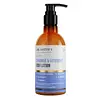What's inside
What's inside
 Key Ingredients
Key Ingredients

 Benefits
Benefits

 Concerns
Concerns

 Ingredients Side-by-side
Ingredients Side-by-side

Water
Skin ConditioningCarthamus Tinctorius Seed Oil
MaskingGlyceryl Stearate Se
EmulsifyingCetearyl Alcohol
EmollientHelianthus Annuus Seed Oil
EmollientGlycerin
HumectantCetearyl Olivate
Butyrospermum Parkii Butter
Skin ConditioningSorbitan Olivate
EmulsifyingDimethicone
EmollientCeramide NP
Skin ConditioningLecithin
EmollientPhospholipids
Skin ConditioningGlycine Soja Sterols
EmollientCannabis Sativa Seed Oil
EmollientRosa Canina Fruit Oil
EmollientSodium Hyaluronate
HumectantTocopherol
AntioxidantLaminaria Ochroleuca Extract
Skin ConditioningAloe Barbadensis Leaf Juice
Skin ConditioningPanthenol
Skin ConditioningAllantoin
Skin ConditioningHydrolyzed Soy Protein
HumectantUlva Lactuca Extract
Skin ConditioningAscorbic Acid
AntioxidantGlyceryl Caprylate
EmollientPotassium Cetyl Phosphate
EmulsifyingGlyceryl Undecylenate
EmollientSorbitol
HumectantCitric Acid
BufferingXanthan Gum
EmulsifyingEthylhexylglycerin
Skin ConditioningPhenoxyethanol
PreservativeWater, Carthamus Tinctorius Seed Oil, Glyceryl Stearate Se, Cetearyl Alcohol, Helianthus Annuus Seed Oil, Glycerin, Cetearyl Olivate, Butyrospermum Parkii Butter, Sorbitan Olivate, Dimethicone, Ceramide NP, Lecithin, Phospholipids, Glycine Soja Sterols, Cannabis Sativa Seed Oil, Rosa Canina Fruit Oil, Sodium Hyaluronate, Tocopherol, Laminaria Ochroleuca Extract, Aloe Barbadensis Leaf Juice, Panthenol, Allantoin, Hydrolyzed Soy Protein, Ulva Lactuca Extract, Ascorbic Acid, Glyceryl Caprylate, Potassium Cetyl Phosphate, Glyceryl Undecylenate, Sorbitol, Citric Acid, Xanthan Gum, Ethylhexylglycerin, Phenoxyethanol
Water
Skin ConditioningEthyl Olivate
EmollientOlive Oil Ethylhexyl Esters
Glycerin
HumectantParaffinum Liquidum
EmollientStearic Acid
CleansingGlyceryl Stearate
EmollientXylitylglucoside
HumectantAnhydroxylitol
HumectantXylitol
HumectantSodium Ascorbyl Phosphate
AntioxidantCetearyl Alcohol
EmollientAloe Barbadensis Leaf Extract
EmollientCocos Nucifera Oil
MaskingDimethicone
EmollientIsopropyl Myristate
EmollientOlea Europaea Fruit Oil
MaskingPolysorbate 80
EmulsifyingCetyl Palmitate
EmollientSodium Acrylate/Sodium Acryloyldimethyl Taurate Copolymer
Emulsion StabilisingHydrogenated Polydecene
EmollientTrideceth-6
EmulsifyingSorbitan Laurate
EmulsifyingCeramide AP
Skin ConditioningPhenoxyethanol
PreservativeCarbomer
Emulsion StabilisingSodium Benzoate
MaskingTocopheryl Acetate
AntioxidantSodium Hydroxide
BufferingPotassium Sorbate
PreservativeDisodium EDTA
BHT
AntioxidantPhyllanthus Emblica Fruit Extract
HumectantWater, Ethyl Olivate, Olive Oil Ethylhexyl Esters, Glycerin, Paraffinum Liquidum, Stearic Acid, Glyceryl Stearate, Xylitylglucoside, Anhydroxylitol, Xylitol, Sodium Ascorbyl Phosphate, Cetearyl Alcohol, Aloe Barbadensis Leaf Extract, Cocos Nucifera Oil, Dimethicone, Isopropyl Myristate, Olea Europaea Fruit Oil, Polysorbate 80, Cetyl Palmitate, Sodium Acrylate/Sodium Acryloyldimethyl Taurate Copolymer, Hydrogenated Polydecene, Trideceth-6, Sorbitan Laurate, Ceramide AP, Phenoxyethanol, Carbomer, Sodium Benzoate, Tocopheryl Acetate, Sodium Hydroxide, Potassium Sorbate, Disodium EDTA, BHT, Phyllanthus Emblica Fruit Extract
Ingredients Explained
These ingredients are found in both products.
Ingredients higher up in an ingredient list are typically present in a larger amount.
Cetearyl alcohol is a mixture of two fatty alcohols: cetyl alcohol and stearyl alcohol. It is mainly used as an emulsifier. Emulsifiers help prevent the separation of oils and products. Due to its composition, it can also be used to thicken a product or help create foam.
Cetearyl alcohol is an emollient. Emollients help soothe and hydrate the skin by trapping moisture.
Studies show Cetearyl alcohol is non-toxic and non-irritating. The FDA allows products labeled "alcohol-free" to have fatty alcohols.
This ingredient is usually derived from plant oils such as palm, vegetable, or coconut oils. There is debate on whether this ingredient will cause acne.
Due to the fatty acid base, this ingredient may not be Malassezia folliculitis safe.
Learn more about Cetearyl AlcoholDimethicone is a type of synthetic silicone created from natural materials such as quartz.
What it does:
Dimethicone comes in different viscosities:
Depending on the viscosity, dimethicone has different properties.
Ingredients lists don't always show which type is used, so we recommend reaching out to the brand if you have questions about the viscosity.
This ingredient is unlikely to cause irritation because it does not get absorbed into skin. However, people with silicone allergies should be careful about using this ingredient.
Note: Dimethicone may contribute to pilling. This is because it is not oil or water soluble, so pilling may occur when layered with products. When mixed with heavy oils in a formula, the outcome is also quite greasy.
Learn more about DimethiconeGlycerin is already naturally found in your skin. It helps moisturize and protect your skin.
A study from 2016 found glycerin to be more effective as a humectant than AHAs and hyaluronic acid.
As a humectant, it helps the skin stay hydrated by pulling moisture to your skin. The low molecular weight of glycerin allows it to pull moisture into the deeper layers of your skin.
Hydrated skin improves your skin barrier; Your skin barrier helps protect against irritants and bacteria.
Glycerin has also been found to have antimicrobial and antiviral properties. Due to these properties, glycerin is often used in wound and burn treatments.
In cosmetics, glycerin is usually derived from plants such as soybean or palm. However, it can also be sourced from animals, such as tallow or animal fat.
This ingredient is organic, colorless, odorless, and non-toxic.
Glycerin is the name for this ingredient in American English. British English uses Glycerol/Glycerine.
Learn more about GlycerinPhenoxyethanol is a preservative that has germicide, antimicrobial, and aromatic properties. Studies show that phenoxyethanol can prevent microbial growth. By itself, it has a scent that is similar to that of a rose.
It's often used in formulations along with Caprylyl Glycol to preserve the shelf life of products.
Water. It's the most common cosmetic ingredient of all. You'll usually see it at the top of ingredient lists, meaning that it makes up the largest part of the product.
So why is it so popular? Water most often acts as a solvent - this means that it helps dissolve other ingredients into the formulation.
You'll also recognize water as that liquid we all need to stay alive. If you see this, drink a glass of water. Stay hydrated!
Learn more about Water